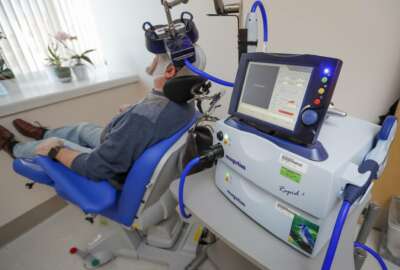
The VA never stops its search for treatments for PTSD
Post Traumatic Stress Disorder is one of those maladies that affects everyone differently and remains beyond any single cure.
Best listening experience is on Chrome, Firefox or Safari. Subscribe to Federal Drive’s daily audio interviews on Apple Podcasts or PodcastOne.
Post Traumatic Stress Disorder is one of those maladies that affects everyone differently and remains beyond any single cure. And that’s why the Veterans Affairs Department continually develops and tests new treatments. To give a sense of the range of work going on with PTSD, the Director for Clinical Science Research and Development in VA’s Office of Research and Development Dr. Terri Gleason, spoke to Federal Drive with Tom Temin.
Interview transcript:
Tom Temin: Dr. Gleason, good to have you on.
Terri Gleason: Good morning, thanks for having me.
Tom Temin: And I’m presuming what I said in the lead is correct, that PTSD is not really any one single thing. And nor does it affect every person affected by it in the same way. Is that fair to say?
Terri Gleason: I think that’s a very fair description. Absolutely. People bring their experience to PTSD. Obviously, it starts with a traumatic experience. And so how individuals express that is also going to be different.
Tom Temin: And how do you go about researching, first of all, how it affects people? I mean, tell us what the research entails, I guess, is what I’m asking.
Terri Gleason: Oh, sure. So in our Office of Research and Development in the VA, we support research from what we call preclinical all the way through clinical and then all the way into practice, meaning putting our results right into practice clinical care in the hospitals. So we conduct studies that look at understanding the biological basis of PTSD, how to treat PTSD based on that understanding. And then when we get the results from clinical trials, as I mentioned, we tried to move them right into clinical practice. So essentially, across the entire research spectrum.
Tom Temin: And is one of the difficulties the fact that unlike, say traumatic brain injury, which is a visible pathology in slides and so forth, PTSD affects people in some degree, depending on what personality and what experiences they have prior to the events that led to the PTSD? And therefore the different psychological makeup of people could affect how the PTSD manifests itself. I imagine that’s a really tough variable.
Terri Gleason: It is a tough variable. And what it means is that we have to understand all of the risk factors, also what an individual is bringing forward, again, as they are exposed to a traumatic experience, and then how it’s received after the experience. So it is a very individual question that you’re asking. But I think in terms of scientific research, what that means is we count on our veterans to participate in our studies. And the numbers that we need to complete, our studies are usually quite robust. So we need a lot of volunteers. And by putting all of that data together, we can make the strongest conclusions about what’s working and what isn’t working.
Tom Temin: And for a veteran to be willing to volunteer, they have to know they have PTSD. Or at least if they know it, they have to acknowledge it. And understand that VA is not putting any sort of stigma on it.
Terri Gleason: Such a good point, yes, we’d like to reduce the stigma around PTSD. But for a clinical trial, for example, if we were examining the benefit of a particular therapy, the individuals that are enrolled in the trial would have to be assessed for PTSD to begin with in order to participate. And then of course, it’s all based on their volunteering to participate in the research as well.
Tom Temin: And what kind of data do you gather to be able to look at it in a objective way, with all of these volunteers?
Terri Gleason: So objectively, we have assessments and these assessments have been tested and validated as well – standard assessments to determine what PTSD symptoms are present, what level of PTSD in terms of severity is present, and then compare, for example, after initially assessing an individual at the end of the trial, in some cases, did that change? Hopefully improved with the new intervention as an example. But we also collect other data, we might be looking at associated conditions. You mentioned TBI earlier and oftentimes TBI is associated with PTSD. So we want to consider that in the final analysis. And other components might include genetic factors, history of trauma, and so forth. So it’s usually a pretty in-depth assessment.
Tom Temin: We’re speaking with Dr. Terri Gleason. She’s director for Clinical Science Research and Development in VA’s Office of Research and Development. And what are some of the recent learnings of PTSD? What do we know now that we didn’t know say five, 10 years ago?
Terri Gleason: I think VA has been at the forefront in many, many stories of success across the research program. Years ago, for example, VA established strong evidence for the benefit of psychotherapy, particular types of psychotherapy in particular, are successful in reducing PTSD symptoms. And so over time, using therapy – also continue to pursue how best to deliver that. There might be cases where individuals start therapy, begin to feel better. And then they may drop out of treatment because it’s long, it takes a long time to get through treatment. And so studies conducting about can we shorten therapy, can we improve upon the therapy in order to keep people engaged and successful all the way through remission of symptoms? Those are a particular story of success, but VA is also working on determining what medications might be more successful. I think the last FDA-approved medications were approved in 2001. So it’s been a long time and a lot of work between now and then to try and figure out are there other areas under the biological underpinnings of PTSD that we can target with drugs and even new drugs? So we’re conducting a lot of studies regarding medication, and the combination of medication with psychotherapy.
Tom Temin: And you mentioned something I want to just follow up on a little bit that in looking at the biological effects of PTSD. There are biological effects in the sense that TBI also has biological effect. Is that correct?
Terri Gleason: Yes, of course, the reaction from a trauma can include over expression of the biology, if you will, and understanding what might be targeted in that overexpression is really important. Something like a sleep disturbance, for example, we could be able to treat with a medication. Those are the types of questions that we continue to support in VA research.
Tom Temin: And doing this research. Of course, the veterans themselves are all over the place. They live across the country from coast to coast. So how do you ensure that the research done with a group in one coast is consistent with the way it’s conducted, say, with a group in the other coast, and a third group somewhere in the Midwest, such that you have comparable research being done in a national level?
Terri Gleason: Yes, that’s such an important question. And VA brings the most unique strength to this. And that is as a national healthcare system, we can conduct and we do conduct multi-site clinical trials. So it’s not uncommon for us to have 10 different sites across the country participating in the exact same protocol. So train the scientists, the docks, that are collecting the data to adhere to the protocol at every single site, and every single participant then is tested in the same way. So the results will be comparable. And I think that’s just a great feature for VA to bring to the table.
Tom Temin: And just for those that might be uninitiated and perhaps encounter a veteran, what are the most common manifestations externally of PTSD?
Terri Gleason: Right, so there is a constellation of symptoms, as you mentioned. So the re-experiencing of the trauma, a hyper arousal is also very common, and that might be an overreaction, people might be on edge, stress comes into play, sleep disorders come into play. And so I think over time, if that behavior continues, or that manifestation continues, that’s the point at which individuals should seek treatment, should talk to their doc about what’s going on, and what could be done to help. Because treatment is successful. There are successful treatments for PTSD. And we really encourage individuals and their loved ones to help seek treatment.
Tom Temin: And just a final question, how do you get best practices for treatment out of VA into say, the psychotherapeutic field, for therapists that may not be connected with VA? Because often there’s this perception, only a veteran can understand a veteran. And I imagine that limits to just the quantity of help that might be available.
Terri Gleason: Right, well, I think in the clinical science field, if we find results from our research, it does have applicability wider than the veteran population. So some of the assessments that I had mentioned earlier would also be used in the general community. Our VA National Center for PTSD is the place the resource for clinicians to look for information. And I will mention one other thing if you don’t mind: We have a coach application for PTSD that’s picked up worldwide, and that helps not only an individual assess their own symptomology but also provides treatment resources as well.
Tom Temin: Dr. Terri Gleason is director for Clinical Science Research and Development in VA’s Office of Research and Development. Thanks so much for joining me.
Terri Gleason: Thank you. It was a pleasure.
Copyright © 2024 Federal News Network. All rights reserved. This website is not intended for users located within the European Economic Area.
Tom Temin is host of the Federal Drive and has been providing insight on federal technology and management issues for more than 30 years.
Follow @tteminWFED




